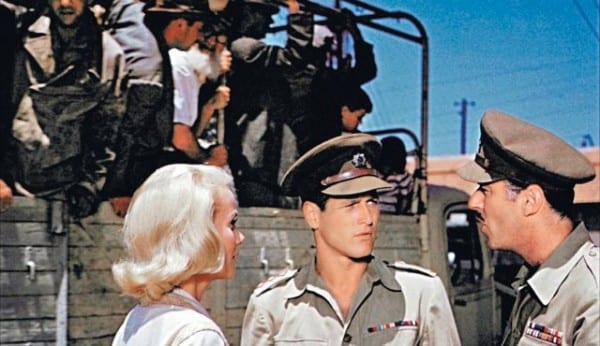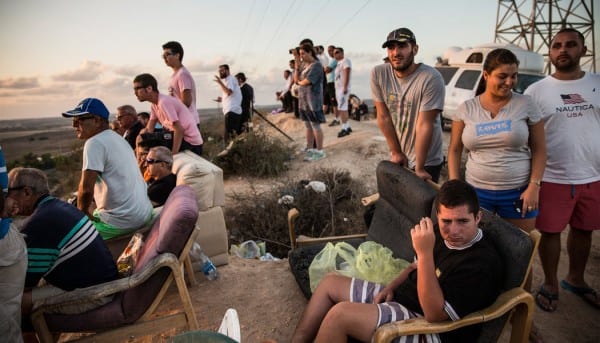[T]he New York Times’ reporting on Israel’s latest assault on Gaza has been a rollercoaster. Unfortunately the high points have been few, short and quickly followed by dizzying and prolonged plunges back into a morass of lazy, credulous recitations of Israeli government talking points, and efforts to portray balance and symmetry in a dramatically unbalanced situation, all permeated by an absence of skepticism and critical analysis, and a failure to explain context. Though Israel has slaughtered over 1000 Palestinian civilians in Gaza and only three civilians have been killed in Israel, in The Times’ upside down world, every Palestinian weapon is a major threat, while Israeli weapons are either defensive or non-existent.
As a result, a few days of strong, urgent reporting by Anne Barnard and Tyler Hickson on the ground in Gaza have been overwhelmed by embarrassing headlines, false equivalencies, and a seemingly unembarrassed willingness to promote Israeli perspectives no matter how obviously outrageous they might be. Who can forget, just in the last days as the Palestinian death toll soared, “Israel Shells Are Said to Hit UN School,” “Israel Says Its Forces Did Not Kill Palestinians Sheltering at UN School,” “Pause in the Fighting Gives Civilians on Both Sides a Moment to Take Stock,” and “Neighborhood Ravaged on Deadliest Day So Far for Both Sides in Gaza;” or these oldies, “Israel on Edge after Possible Revenge Killing of Arab Youth” and “Missile at Beachside Gaza Cafe Finds Patrons Poised for World Cup”?
At its worst The Times’ reporting on this crisis has reminded some readers of Judy Miller’s and Michael Gordon’s enthusiastic shilling for the US attack on Iraq.
There is so much that could be written about these failures, but I’ll focus on a few highlights – The Times’ failure to examine Hamas’ involvement in kidnappings or the manipulation of information about Israeli teens’ deaths, The Times’ failure to explain basic context about Gaza, Times’ explainers that grossly distort reality, and the papers’ hyping of Palestinian military capacity, in contrast to the invisibility of Israel’s massive arsenal.
Failure to Examine Hamas’ Involvement in Kidnappings or the Manipulation of Information about Israeli Teens’ Deaths
The stage was set early by The Times’ reporting on the development of the current crisis. When the Israeli government launched a crackdown on Hamas in the West Bank, blaming Hamas for the abduction of three Israeli teens in early June, The Times generally repeated Israeli government claims of Hamas responsibility for the kidnapping, while also occasionally introducing some uncertainty about Hamas involvement, and at least once quoting Hamas denials of those claims. But The Times never published a piece examining the suspicious lack of clear evidence that Hamas was responsible, unlike Shlomi Eldar on Al Monitor or Sheera Frenkel onBuzzfeed. And in the last weeks, as some Israeli authorities have been quoted saying that they had concluded that Hamas was not responsible for the abductions and killings, The Times has not looked back. The growing consensus that the Israeli government based the escalation against Hamas that led directly to the current fighting in Gaza on false claims seems not to interest The Times.
Even more damning, however, The Times’ Jerusalem-based reporters never examined the revelation that the Israeli government likely knew from day one that the three teens were killed by their kidnappers within hours, even as the Israeli government launched a massive manhunt and PR campaign for their freedom, and claimed they were operating on the presumption that the teens were alive. Gunshots could be heard followed by a groan in an audiotape of a call from one of the teens to the police that was circulating in Israel. Additionally, shell casings, blood and DNA found in an abandoned car suggested the teens were killed there. The Israeli government placed this information under a gag order, but the rumor of gunshots on the audiotape were reported on social media almost immediately, and later detailed by outlets like this site on June 23.
The existence of the audiotape was brought to the attention of Times Jerusalem Bureau Chief Jodi Rudoren on June 24 on skype by Mondoweiss reporter Allison Deger. Deger tweeted at Rudoren, “I’m sure @rudoren can find out about the emergency call details for herself if she wants to dig…” The seemingly out of it Rudoren responded on twitter to the series of tweets, “What recording?” Rather than seeking a scoop that might have contradicted the Israeli government narrative, The Times didn’t report on the recording until July 1, after the Israeli government lifted the gag order on the audiotape. Rudoren’s report on the call was minimal, and included no examination of the fact that the Israeli government very likely knew almost immediately that the teens were dead, though they told the public for weeks that they presumed them to be alive.
It was left to Times blogger Robert Mackey to publish a July 10 piece that did not make it into the print newspaper. Mackey questioned whether
“keeping salient facts of the investigation secret for weeks allowed a government-backed social-media campaign to channel outrage over the abductions to grow, but also set the public up for crushing disappointment once the bodies were discovered.”
That outrage, fed by the unexamined, dubious accusations against Hamas, led directly to overwhelming Israeli support for a brutal attack on Gaza. Times readers who did not read between the lines, read this Robert Mackey blog post, or seek out other sources of information were left largely in the dark about these key facts.
Failure to Explain Basic Context in Gaza
Times readers also probably lack an understanding of the broader context of the events in Gaza, again due to the paper’s poor reporting. In the run-up to Israel’s current assault on Gaza, The Times had neglected the Gaza Strip. According to my repeated searches of The New York Times’ website (which while thorough still could miss stories), Jerusalem Bureau Chief Jodi Rudoren reported from Gaza only one time during the 16 month period between December 2012 and April 2014. Rudoren defended this in a March 2014 email exchange with Mondoweiss by saying “we rely on our excellent Gaza-based stringer,” and noting some of the stories that they published. But it seems from the content of the articles that Fares Akram is not given much latitude in his reporting. During one seven-month period when Rudoren was completely absent from Gaza (8/13 – 3/14), I counted 27 New York Times stories reported from Gaza. Only five focused on the difficulties of life in Gaza, though those difficulties are severe.
My review of recent Times articles shows that the paper has generally failed to explain the basics: that most of Gaza’s residents are refugees from the area from which Israel launches attacks on Gaza, that Gaza remains under Israeli military occupation and a siege, and that Gaza is increasingly unlivable. The Times very infrequently uses the words occupation, siege and blockade to describe Gaza, and when it does they are most often in quotes from Palestinians. Over the last four weeks, The Times has noted a handful of times in a brief paragraph Israel’s control of land, sea and airspace around Gaza, and broached the words occupied and siege. [The Times also forgets to mention that the Gaza zone was created as a result of massive land dispossession literally at gunpoint in
The Times noted just once in 2012, when the relevant UN report was published that the UN has predicted that Gaza, one of the most densely populated places in the world, may be unlivable by 2020 due to deteriorating drinking water quality, inadequate electricity supply and infrastructure, growing population and the impacts of Gaza’s isolation from the world. Finally, while The Times has reported on some of Israel’s attacks on and killing of Gazans throughout the ceasefire of the last two years, it has failed to explain that, “even when rocket fire comes to a halt as called for by the cease-fire agreement, Israel continues its violations with total impunity,” as documented by Yousef Munayyer at the Palestine Center.
Two Times’ “Explainers” that Grossly Misrepresent Reality
For the last 24 days The Times has published an online summary of “The Toll in Gaza and Israel, Day by Day” that depicts a completely false sense of near parity between Palestinian and Israeli military attacks. As of August 1, 2014 the summary notes “3,834 targets in Gaza struck by Israel” versus “2909 rockets launched at Israel by Gaza,” a ratio of 1.32 to 1. The showcasing of these figures, implying near parity, is suggestive of a desperate effort by The New York Times to provide a counter to the only other figures in “The Toll in Gaza and Israel” that show a stunning disparity between the number of Palestinian than Israeli deaths.
A series of July 30 tweets at Jodi Rudoren by Amnesty USA’s Middle East and North Africa Advocacy Director Sunjeev Bery explained that The New York Timescomparison between targets struck and rockets launched is misleading. Both figures come from the Israeli army, which has an interest in spinning the numbers. Also, the statistic on targets struck by Israel neglects “scale of IDF munitions.” One “target” in Gaza can be hit by multiple Israeli strikes of munitions of varied sizes. Plus, Israeli bombs and shells are on average significantly heavier than the small Palestinian rockets. Bery’s tweets of concern about these Times statistics wereseconded on twitter by Human Rights Watch’s Middle East Director Sarah Leah Whitson.
Closer analysis shows that Israel has probably shot and dropped more than five times the tonnage of ordnance that Palestinians have fired at Israel. As of July 16th,Human Rights Watch, reported, Israeli officials said that Israeli attacks in Gaza had “delivered more than 500 tons (1 million lbs) of explosives in missiles, aerial bombs, and artillery fire.” The New York Times “toll in Gaza” shows that 1274 rockets had been launched from Gaza at Israel by that date. Using the 65 kg (143 lbs) weight of a grad rocket frequently fired from Gaza as an average for a rocket from Gaza, Palestinians would have fired approximately 182,182 lbs of ordnance at Israel by that date. Thus Israel had fired approximately 5.49 times as much ordnance at Gaza as Palestinians had fired at Israel as of July 16th. This disparity has likely increased since then as Israel has intensified its attacks, including very heavy shelling. Furthermore, fired Palestinian ordnance is extremely inaccurate compared to targeted Israeli ordnance and thus far less likely to hit anything, and some Palestinian rockets are shot down by Israel’s “Iron Dome.”
Though the comparison between “targets in Gaza struck by Israel” and “rockets launched at Israel by Gaza” is inappropriate and deceptive, The New York Timeshas persisted in using it, even after the issue was raised with the paper by a number of people.
This Friday The New York Times introduced a second problematic comparative “explainer” graphic, “In Gaza, a Pattern of Conflict.” This explainer purports to show “similarities and differences in the last three major conflicts” between Israel and Palestinians in Gaza in 2008/09, 2012 and 2014. However, this “Pattern of Conflict” explainer begins with an inaccurate historical summary, asserting that Hamas started each conflict: “Hamas launches volleys of rockets into Israel; Israeli warplanes strike targets in Gaza. This has escalated into an Israeli ground invasion twice.” This explanation of how the three conflicts started incorrectly places all the blame on Hamas, and none on Israel, repeating standard Israeli talking points.
In contrast, in summarizing the Israel’s Operation Cast Lead which began in 2008, The Institute for Middle East Understanding notes, “a situation of relative quiet prevailed in and around Gaza until November 4, when Israeli soldiers staged a raidinto the Strip, killing six members of Hamas. The attack… ended the ceasefire and led to an escalation of hostilities culminating in Cast Lead the following month.”The New York Times’s own report from November 4, 2008 explained, “Israelcarried out an airstrike on Gaza on Tuesday night after its troops clashed withHamas gunmen along the border in the first such confrontation since a cease-fire took effect in June. Five militants were killed…”
Robert Wright reported a detailed 2012 timeline developed by Emily Hauser. It included the November 4, 2012 killing of a mentally-disabled Palestinian, the November 8 killing of a Palestinian boy, the November 12 killing of four Palestinian fighters, Palestinian rockets fired into Israeli on November 11th, and then Israel’s assassination Hamas military leader Ahmed Jabari and eight other Palestinians.
The most recent conflict can be traced back to the Israeli government’s aim of breaking up the new Fatah-Hamas endorsed Palestinian authority, the kidnapping and killing of three Israeli teens and then one Palestinian teen, and Israel’s crackdown against Hamas in the West Bank and Gaza Strip.
To top off the misrepresentation that Hamas started the three conflicts, the “explainer” includes a graphic depicting “cumulative rockets fired at Israel from Gaza.” Perhaps realizing late in the game that “targets struck in Gaza by Israel” is fatally flawed, the new explainer thus depicts military attacks in the conflict as only by Palestinians. In summary, the explainer suggests that Palestinians started the conflict and implies that only Palestinians launch attacks.
The Hyping of Palestinian Military Capacity and the Invisibility of Israel’s Massive Arsenal
The same narrative emphasizing Palestinian rockets dominated The New York Times early reporting on both sides’ military capacity in this 2014 conflict, before Palestinian tunnels evolved to become a second focus. In the first weeks The Timespublished two stories detailing Palestinian rockets – “A Growing Arsenal of Homegrown Rockets Encounters Israel’s Iron Dome” and “From Gaza, an Array of Makeshift Rockets Packs a Counterpunch.” The only Israeli military weaponry that garnered any attention in those articles was Israel’s defensive “Iron Dome,” despite the fact that Israel was wiping out entire Palestinian families with bombs dropped from F16s, with shells from tanks, rockets fired from drones, and shells and rockets fired from gunboats. Even The Times explainer described above never names an Israeli weapon, instead noting passively “targets struck.”
Then, following a PR push by the Israeli government, Israel’s tunnels became a focus of The New York Times’ reporting. First The Times published a Q&A on the tunnels that included a fancy map and a video courtesy of the Israeli government. Then, after she went on a guided tour by the Israeli army, The Times Jodi Rudoren published her own piece hyping the tunnels, “Tunnels Lead Right to the Heart of Israeli Fear.” Avoiding any mention of the fact that no Israeli civilian has been injured or killed in an attack from a tunnel to date, as noted by Greg Mitchell andothers, Rudoren’s article included a breathless, overblown narrative about the terror tunnel threat, saying, “In cafes and playgrounds, on social-media sites and in the privacy of pillow talk, Israelis exchange nightmare scenarios that are the stuff of action movies: armed enemies popping up under a day care center or dining room, spraying a crowd with a machine gun fire or maybe some chemical, exploding a suicide belt or snatching captives and ducking back into the dirt.”
Then, sounding practically like an Israeli spokesperson, Rudoren continued on The Takeaway and CNN to sell the threat of the tunnels to American audiences. In contrast, Anne Barnard’s US media appearance that I was able to locate lacked this type of one-sided tone.
Despite all the attention paid to rockets and tunnels, including four New York Times articles in three weeks, no Israeli civilians have ever been killed in an attack from a tunnel, and Palestinian rockets and mortars have killed a total of 40 Israelissince 2001, six during this current 2014 conflict. On the other hand, I can’t remember ever seeing a New York Times article focusing on Israel’s huge military arsenal which has killed over 8000 Palestinians since 2000. Lethal Israeli F16s, drones, tanks and gun boats that are tearing apart hundreds of Palestinian children seem non-existent and invisible to the paper.
The angle that the US provides billions of dollars in military aid to Israel and that many of Israel’s weapons are made in the US doesn’t evoke any interest from The Times either. Even the US government’s recent decision to resupply Israel with mortars and grenades at the same time that the US government was criticizing Israel’s shelling of a UN school was not deemed newsworthy enough by The Timesto break its silence on Israeli weapons.
* * *
With a few exceptions, The Times reporting on Israel’s ongoing assault in Gaza has been dreadful and deserves condemnation. The paper has deliberately obscured or lazily failed to examine key events and realities, and presented information in a way that attempts to portray a balanced conflict where both sides are suffering similarly, rather than the reality of a one-sided Israeli massacre of Palestinian civilians. The Times has omitted key facts in a way that hypes threats to Israel while obscuring Israel’s overwhelming power, and control over and brutal repression of Palestinians. All this seems aimed at shielding Israel and the US, Israel’s most dedicated and uncritical backer, from facing the troubling realities that most of the rest of the world now sees. The New York Times has taken on the role of comforting powerful Israeli and US elites, while afflicting the comparatively powerless and brutalized Palestinian people, and obfuscated Israeli war crimes. In all these respects The Times is little different from other US mainstream media outlets, but it is perhaps more important because it is seen as a leader that other US media and US elites follow.
Do I think The New York Times’ coverage is likely to improve following criticism? Unfortunately, after observing The Times’ reporting on Israel and Palestine closely for more than ten years, I don’t think more than marginal change is likely, because these biases seem deeply entrenched at many levels within the paper. What seems more likely is that continued coverage of this sort will further discredit the paper, and more people will turn to alternative sources for their information.
About Patrick Connors
Patrick Connors is a member of Adalah-NY: The New York Campaign for the Boycott of Israel.
__________
ABOUT MONDOWEISS—A unique resource
A word about its editors
[1] Its founder describes himself as a progressive and anti-Zionist.[3]
[8] Esquire, and The New York Observer.[9][10] He is the author of Cock-a-Doodle-Doo (1996)[11] and American Taboo: A Murder In The Peace Corps (2004).[12]
Near Eastern Studies from New York University.[13] He later served as the Director of the Israel/Palestine Program for the American Friends Service Committee[13] where he gained “extensive on-the-ground experience in Israel/Palestine.”[14] In addition to Mondoweiss, Horowitz has written for The Nation, Alternet, The Huffington Post, and The Hill.com.[13][15] Horowitz wrote the foreword to Rabbi Brant Rosen’s book Wrestling in the Daylight: A Rabbi’s Path to Palestinian Solidarity.[16] He has spoken frequently on the Israeli-Palestinian conflict on campuses and to organizations.[17][18]
Alex Kane, an assistant editor for Mondoweiss based in New York City, also is the World editor for AlterNet.[19] His work also has appeared in Salon, The Daily Beast, the Electronic Intifada, Extra! and Common Dreams.[2









